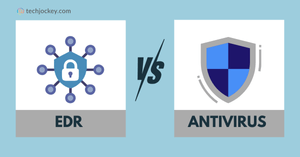What is Endpoint Detection and Response Software?
Endpoint detection and response (EDR) software is the latest addition to the endpoint security family. It combines the components of both endpoint management solutions and endpoint antivirus to investigate, detect and remove any malware that can penetrate network devices.
This security solution combines endpoint information and real-time constant monitoring with analysis capabilities and regulations-based automated responses. The edr security software gives a clear picture of the overall health of a system, including the condition of each device. Organizations rely on this software to prevent data loss, system failures and theft. It is primarily used as an additional security layer to larger security systems like security information and event management (SIEM), incident response tools and vulnerability management.
Why Use Endpoint Detection & Response (EDR) Software?
Endpoint Detection & Response EDR Software is used for several important reasons that include:
- Threat Hunting: EDR tools assist in identifying targeted and advanced threats on several endpoints such as laptops, servers, computers, and mobile devices within a network. It constantly tracks endpoint activity, identifies indicators of compromise (IOCs) and analyses their behaviour for a potential breach in security.
- Improving Security Posture: By using EDR software solutions, organizations can significantly enhance their security posture. Owing to the proactive threat detection and incident response capability, the security team can detect as well as respond to threats efficiently. This drastically reduces the impact of security incidents and reduces the attacker's dwell time.
- AI-Powered Tools: Endpoint detection & response software utilizes AI technology to find out patterns in events and processes that indicate malicious activities and threats. This software can also determine attack paths that are difficult to find for a human analyst. Moreover, it provides a complete remediation process for a particular event, ensuring a similar incident doesn't occur again.
Key Features of Endpoint-Detection-and-Response Software
Some of the key features of EDR software include threat detection, endpoint visibility, containment, and behavioural analytics. Let's look at all these attributes in detail.
- Threat Detection: The endpoint malware detection software uses advanced techniques such as threat intelligence, machine learning and behaviour analysis to identify anomalies and malicious activities at endpoints. This software can detect various threats like ransomware, malware, advanced persistent threats (APTs) and more.
- Containment: Once the threat is detected, EDR facilitates faster response by issuing real-time notifications and alerts to restrict its access from the greater network as well as additional endpoints. It allows security teams to quickly respond and investigate the incident, to prevent further damage.
- Endpoint visibility: EDR allows you to have comprehensive visibility into all endpoints, including servers, workstations, mobile devices, and laptops. It monitors and collects data from multiple sources like system logs, user behaviour, and network traffic to gain valuable insights into potential threats.
- Behavioural analytics: Endpoint detection and response software uses behavioral analytics to set up a baseline for the normal behaviour of all endpoints and detect any variation. This feature helps in identifying suspicious activities like privilege escalation, lateral movement, and data exfiltration. Moreover, it also helps in detecting targeted and advanced attacks that may avoid traditional defence systems.
- Real-time monitoring: The continuous and real-time monitoring feature allow security teams to continuously monitor systems to detect any anomaly instantaneously.
- Threat documentation: Incident data recording ability automates the curation and collection of incident data. This data is then used to alert the security teams about the health and performance of the organization's endpoint devices.
Major Benefits of Using Endpoint-Detection-and-Response Software
EDR software can help organizations in identifying undetected threats, reduce false positives, streamline cybersecurity and more.
- Loss Reduction: Endpoint detection and response software is essential for businesses that rely on systems and data for smooth operation. Using this software keeps the data safe, secures the network and mitigates the risk of cyberattacks and many other security threats. Thanks to endpoint protection, critical business data is protected from hackers and loss during a disaster. It ensures that your remote workers are never at risk of data breaches and malware attacks. Ultimately, EDR software ensures peace of mind for everyone involved - employees, executives and customers.
- Reduce False Positives: EDR software thoroughly investigates suspicious activities before alerting the security team. After investigation, if the event is found to be harmless, then the alert is closed. This drastically reduces the number of false positives your IT team must examine. Security teams have to deal with false alerts every day, which hampers their efficiency, hence having a solution that can deal with this problem is a boon for them.
Streamlining Cybersecurity
It is extremely critical for your businesses to have a cybersecurity solution that is easy to use and streamlined. By having such a solution at your disposal can help in ensuring data security, endpoint protection and compliance with numerous regulations. With the help of cybersecurity audits, you can ensure the confidentiality of critical data and it also creates a sense of security for your customers. Moreover, top-notch cybersecurity reduces the chances of disruption because of data breaches.
Determine the Path of Malicious Attack
By identifying and eliminating malicious files, you can only handle the immediate problem. But often, security experts are unaware of the path from where the threat entered the system and what it did before identification. Using an EDR tool provides 'threat cases' which identifies all attacks before detection and also gives details about the path of attack. The attack chain is represented in the form of visual data, which helps experts in understanding the cause of the attack and where it went after that.
What is the Cost of EDR Tools?
On an average the EDR tools cost between a range of $12.99 to $109.99 per year. Some of the most famous EDR tools along with their pricing are mentioned below:
| Software | Price |
| Microsoft Defender for Business | $3.00 per month |
| Armor | $2.40 per month |
| Bitdefender GravityZone | $184.99 one-time |
| CyFIR Investigator | $5.00 one-time |
| Emsisoft Anti-Malware | $29.99 per year |
| GorillaStack | $50.00 per month |
Latest Endpoint-Detection-and-Response Software Trends
Here are some of the most noteworthy trends in endpoint detection and response software.
Automation
Online security experts must pay close attention to the security of their organizations. One key aspect they can use to incorporate this measure is by opting for automated tools. Companies are increasingly opting for automation to detect threats, vulnerability management, detection controls and endpoint protection. Additionally, automation can also enhance endpoint security, allowing complete visibility of the system and the speed of response.
Managed Security Service
Another reliable strategy that is in demand nowadays is managed security service. Many companies now look to outsource all or some part of their cybersecurity operations to managed security service providers. It is a service capability or service model by cybersecurity companies to monitor security systems, devices, and software as a service (SaaS) application. These service providers primarily deliver EDR security services remotely or in-house, mainly through the cloud.
Inclusion of Mobile Devices
Earlier, EDR software was used to monitor and manage the security of laptops and PCs, but now it has expanded its reach to smartphones and tablets. As companies rely on mobile devices due to hybrid or remote work, even one single compromised mobile phone can cause a threat to client data and intellectual property. This could also lead to the loss of business revenue, hence most EDR companies have added mobile device protection and management to their repertoire.
Third-Party and Supply Chain Endpoints
There is a surge in attacks via third-party and supply chain endpoints. As these endpoints are getting compromised, it's causing enterprise data loss. Therefore, the latest EDR tools are adjusting to provide security to supply chains and third-party endpoints. Moreover, some solutions come with features that segregate enterprise content from third-party content.
Considerations When Buying EDR Software
Here is a list of five key considerations that’ll help you choose the right endpoint detection and response (edr) solution for your business.
Defence & Recovery Against Ransomware
Ransomware is considered the most harmful form of malware to date therefore, you should check how an EDR tool responds to all forms of ransomware. You should also check whether it can provide protection when the endpoint is working in an offline mode. Another consideration is around the real-time rollback facility and checking the number of systems it can conduct the rollback process on.
Anti Tampering Facility
Attackers seek ways to damage the system's firmware with ransomware attacks. Understand how your solution can protect the device from these kinds of attacks. They also use malicious bootloader that aims to delete files from windows defender, Microsoft security essentials and others. If the malware succeeds, this makes it almost impossible for experts to retrieve files, use the system or even roll back all damages, which can be disastrous for retail and healthcare companies. The EDR you want to purchase must act as a firewall at the Kernel level of your system to ensure its safety against attempted breaches.
Integration with Existing Security Solutions
Your company will likely use other security solutions other than EDR, hence your security team needs to determine how an EDR tool with work in tandem with other security software on board. There is a chance that some features might overlap each other, but make sure that they don't disrupt each other. Many security vendors are now building software that can easily integrate with other applications. Some even highlight this feature as their main selling point.
Frequency of Software Updates
As attackers try to beat the security system by using new techniques and tactics, you need EDR software that gets constant updates on Indicators of Attacks (IoA) and (IoC). Some companies even allow organizations to customize their IoAs and IoCs. Moreover, there are companies that hire an internal team for creating machine learning algorithms to find out anomalies that might cause potential threats.
Potential Issues with Endpoint Detection & Response (EDR) Software
Driver Issues
Standalone endpoint detection and response software that only provides support at the user level, not at the Kernel level, needs separate drivers to monitor threats. This sometimes results in redundancy issues and driver conflicts in the system.
Redundancy of Management & Agent Console
You need antivirus functionality in your endpoint detection and response (edr) software to block known threats. But sometimes this facility is not available in the system, in this case, security managers install two agents, one on the user's PC and the other one on the management console. It means a security expert will have to manage a management console as well as an agent on the user's PC, which causes the wastage of resources.
EDR software detects each action as a separate event and then requires human input for analyzing the procedure. Some standalone endpoint and detection solution forces the security team to do the repetitive task of managing false positives and do over detection by examining the threat flow charts.
EDR Cost
According to a recent study, 69% of companies feel that risk in endpoint protection has increased due to the high cost and complexity of endpoint protection solutions. Owing to the trade-off between number of endpoints, resource limitations and total budget, organizations are dealing with gaps in their security system, and it is making them susceptible to cyberattacks.































